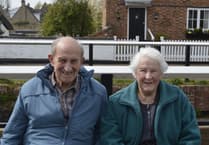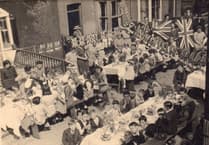ALTON Morris are a familiar sight in and around the town, with their colourful red and green faces, jangling of bells and lively clashing of sticks. They have been relied upon to liven up many an event or public gathering.
Formed in 1979, the team of dancers has evolved over the years from being an all-male Cotswold team to a mixed-Border side, bringing traditional music and dance to brighten up even the dullest of days.
Morris dancing is a generic term used to cover many styles of English ritual dancing that have developed over time; these include Cotswold, Border, Rapper, Long Sword, North West and Garland Dancing. The styles developed regionally but are now danced by ‘sides’ – or teams – in all parts of the country.
The dances were originally performed to celebrate specific occasions such as May Day and various festivals. It has become a recreational activity, danced for pleasure and fitness, practiced on winter evenings and danced out widely in the summer months.
Morris dancing is thought to have originated in Spain as a musical dance interlude between acts of plays to keep audiences entertained. It became fashionable at court and spread throughout Europe, working its way over to England in the 1500s. Unfortunately, the craze died out in most of Europe, surviving only in Britain, booming in the Victorian era and then fading away around the time of the First World War due to many villages losing their dancers.
In the 1930s, Morris began to revitalise, booming again in the 1960s, 1970s and 1980s alongside the increased popularity of folk music. In more recent years, the dancing has taken on new forms with clubs inventing new styles to create more modern versions of Morris.
Alton Morris was first formed in 1979 as a male Cotswold team, Cotswold being the style that most people think of as Morris – dancers in white shirts with coloured sashes - or ‘baldricks’ – bells on their knees and waving sticks or hankies. The Alton dancers were famous for their red woollen hats modelled on a brewers hat seen in the town museum.
In the late 1980s there was a decline in membership and it was decided to re-vitalise the side by welcoming female dancers and performing Border Morris. This style originated in villages along the English side of the Wales-England border in the counties of Herefordshire, Worcestershire and Shropshire. The kit is different for this lively and entertaining dance tradition and includes ragged jackets and painted faces. Traditionally, faces were blackened perhaps because the original dancers were men, out of work in the winter, who played and danced to earn money. This may have been seen as begging so they blacked their faces as a disguise.
Nowadays, dancers have a choice of coloured face paint to look less menacing. Alton Morris chose red and green.
The first public performance of Alton Morris in its Border incarnation was in October 1991, when the side performed at a Tree Aid barn dance in the Alton Assembly Rooms. Somewhere along the way there was a lively debate on the subject of the balance of men and women in a set and any idea of equal numbers dancing opposite each other was abandoned in favour of completely mixed sets. The kit became the same for men and women.
Alton Morris had, by 1993, completed its re-incarnation.
You will see the Alton Morris dancing at many local pubs and events such as the Yuletide festival, Blackmoor Apple Tasting and many local festivals.
Over and above the annual cycle of folk festivals in the South of England, the season often includes events that involve travel to new locations in the UK and abroad.
The town of Alton is twinned with Montecchio Maggiore in Italy and also, more recently, with Pertuis in France. Alton Morris has involved itself fully in the twinning activities, entertaining Italian and French visitors at home and going to both towns.
In 1999, they were the first group of visitors from Alton to go to the newly-twinned Italian town.
“We were very pleased with the major adjustment that the Italians had to make to their view of the English as a reserved and undemonstrative nation,” says Don Hammond, one of the founder members of the side.
“The sight of a large room full of Italians joining in the dancing with their faces painted, brandishing ‘bastone’, many in borrowed flowered hats and tattered jackets, is to be treasured. We made a second visit in 2005. Our Pertuis expedition was in 2010. A great trip, that we look forward to repeating, dancing in some lovely Provencal villages.”
Alton Morris is a lively, friendly side for both men and women. From October to April they practice on Friday evenings in Alton. New dancers and musicians are always welcome. To get involved, e-mail [email protected] or contact Sel on 07789 722728 or Don on 07860 232336.





Comments
This article has no comments yet. Be the first to leave a comment.